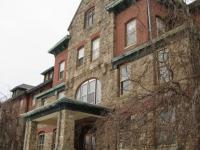Isaiah Williamson was born into a family of Quaker farmers in Fallsington, Pennsylvania (Bucks County) on February 4, 1803. Raised on the family farm alongside seven siblings, by 1818, Williamson had begun working as an apprentice in a store near his home. Over the course of the next seven years, he saved enough money to open and run his own dry goods store in Philadelphia. This store proved to be a success, allowing Williamson to pursue several other business activities, all of which were also remarkably successful. Thanks to his business acumen, in 1838, Williamson was able to retire at the age of 35 with a small fortune. He spent the next couple of years traveling across Europe, as many wealthy men did at that time, but it was a lifestyle for which he was not cut out. Returning to Philadelphia, Williamson invested his money in various enterprises, including real estate, and by the 1880s, he was one of the richest men in Pennsylvania.
Having acquired such wealth, Williamson felt compelled to use his money for the benefit of 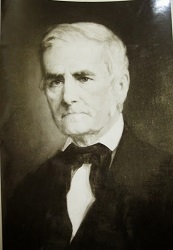 others. Throughout the Delaware Valley, Williamson (pictured at right) donated funds to various orphanages, libraries, colleges, benevolent societies, and other organizations, but always anonymously or using a pseudonym. After frequently seeing young boys on the streets with no education or knowledge of how to create a better life for themselves, Williamson was inspired to establish a school where young men could be taught a trade free of tuition. In December of 1888, Williamson Free School of Mechanical Trades was established with an endowment from Williamson. Early in 1889, Williamson and a group of trustees visited a location in Middletown Township, Delaware County (near Media) as a possible site for the school to be built. Shortly after that visit, Williamson became ill and died in March of 1889. Nevertheless, the trustees pushed on and purchased over 200 acres of the land they had seen with Williamson, and contracted Frank Furness, a well-known Philadelphia-based architect to design the school’s buildings. In 1891, the Williamson Free School of Mechanical Trades opened and following Isaiah Williamson’s wishes, the poor were given preference during the admission process, every student was awarded a scholarship that covered the complete cost of their education (tuition, room, board, and books), and the Quaker ideals of honesty, frugality, hard work, and religious faith were incorporated into the values of the school. Initially, the school offered vocational training for high school-aged men in areas such as bricklaying, carpentry, and machine shop; since becoming a post-secondary institution in 1961, the school now offers associate degrees in various fields of specialized technology.
others. Throughout the Delaware Valley, Williamson (pictured at right) donated funds to various orphanages, libraries, colleges, benevolent societies, and other organizations, but always anonymously or using a pseudonym. After frequently seeing young boys on the streets with no education or knowledge of how to create a better life for themselves, Williamson was inspired to establish a school where young men could be taught a trade free of tuition. In December of 1888, Williamson Free School of Mechanical Trades was established with an endowment from Williamson. Early in 1889, Williamson and a group of trustees visited a location in Middletown Township, Delaware County (near Media) as a possible site for the school to be built. Shortly after that visit, Williamson became ill and died in March of 1889. Nevertheless, the trustees pushed on and purchased over 200 acres of the land they had seen with Williamson, and contracted Frank Furness, a well-known Philadelphia-based architect to design the school’s buildings. In 1891, the Williamson Free School of Mechanical Trades opened and following Isaiah Williamson’s wishes, the poor were given preference during the admission process, every student was awarded a scholarship that covered the complete cost of their education (tuition, room, board, and books), and the Quaker ideals of honesty, frugality, hard work, and religious faith were incorporated into the values of the school. Initially, the school offered vocational training for high school-aged men in areas such as bricklaying, carpentry, and machine shop; since becoming a post-secondary institution in 1961, the school now offers associate degrees in various fields of specialized technology.
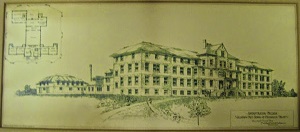
Drawing of Williamson Free School administration building designed by Frank Furness
To honor Isaiah Williamson and in remembrance of his generous endowment for the school, his remains are located in an inscribed stone tomb under the stairway leading up to the school’s administration building. Inside the administration building, the George F. Heckler Archives preserves and makes accessible the school’s archival collections, which include the Isaiah V. Williamson financial papers, 1835-1898; the Williamson Free School of Mechanical Trades records, 1746-2014 (bulk 1888-2014); and the Cornelia Hennigan research on the Williamson Free School of Mechanical Trades, circa 2000-2008.

Tomb of Isaiah Williamson (1803-1889)
Isaiah Williamson’s financial papers consist of various documents and volumes relating to his financial interests, including some legal and estate papers dating from after his death, as well as some newspaper clippings of Williamson's obituary and research on Williamson, his family members, and associates. Some of these materials, especially the correspondence, document Williamson’s donations to various Delaware Valley area organizations. If using a pseudonym, Williamson often went by “Hez.”
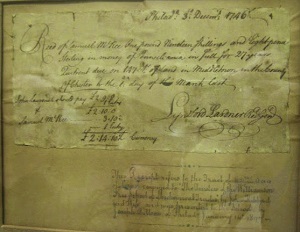
A 1746 receipt for a parcel of land, which was eventually conveyed to the Trustees of Williamson Free School in 1897
The Williamson Free School records consist of about 150 linear feet of materials. The largest portion of this collection is publications, photographs, and audiovisual material. Also present are Board of Trustees records, correspondence of past presidents, financial ledgers, administrative records, documents relating to the buildings and grounds, records from groups such as the Ladies Auxiliary and the school’s alumni association, and materials relating to the faculty and staff, students, school events, and the school's curriculum.
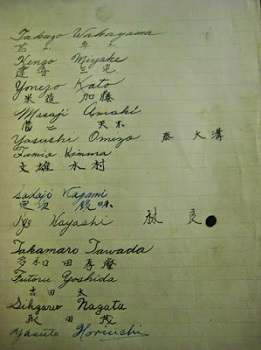
A page of a volume from Williamson's Japanese-American Friendship Exchange program showing signatures from students in Nagoya, Japan (part of the Tokai region), 1933
In addition to the school’s records and the financial papers of Isaiah Williamson, the school’s archives contain research materials from former school historian Cornelia Hennigan that she compiled while writing a history of the school from 2000 to 2008. Hennigan worked at Williamson Free School in a variety of capacities, including resident life, from 1994 to 2009. Her manuscript was never published, but her research files contain materials (mostly photocopies) relating to various subjects and people associated with the school, as well as indices she created to several primary-source Williamson records (such as meeting minutes), which could be very convenient to other researchers.
There are only a handful of schools in the nation that are tuition-free, and Williamson is the only trade school in the United States where the scholarships cover the cost of tuition as well as room, board, and textbooks. Thanks to Isaiah Williamson’s vision- and generous endowment- the school is able to continue to provide these scholarships today. If you are interested in learning more about this type of school or its activities, students, faculty and curriculum, or if you’re curious about Isaiah Williamson and his financial prowess, be sure to investigate the archival collections at Williamson Free School of Mechanical Trades (as of summer 2015, known as Williamson College of the Trades).
Work Consulted
Levenick, Christopher. "Isaiah Williamson." Philanthropy Roundtable. Accessed January 29, 2015. http://www.philanthropyroundtable.org/almanac/hall_of_fame/isaiah_williamson.

